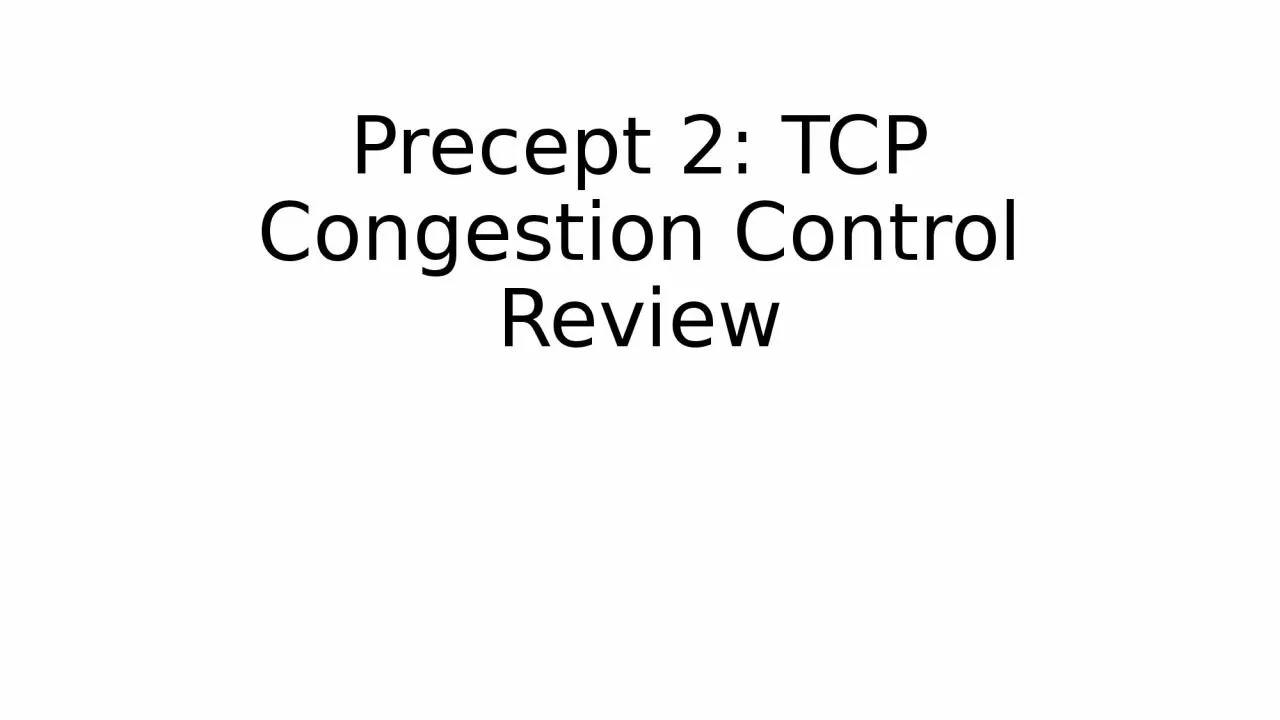

Q1 The size of the TCP Receive window never changes throughout the duration of the connection TCP Basics Q1 The size of the TCP Receive window never changes throughout the duration of the connection ID: 1003023
Download Presentation The PPT/PDF document "Precept 2: TCP Congestion Control Review" is the property of its rightful owner. Permission is granted to download and print the materials on this web site for personal, non-commercial use only, and to display it on your personal computer provided you do not modify the materials and that you retain all copyright notices contained in the materials. By downloading content from our website, you accept the terms of this agreement.
1. Precept 2: TCP Congestion Control Review
2. Q1: The size of the TCP Receive window never changes throughout the duration of the connection?TCP Basics
3. Q1: The size of the TCP Receive window never changes throughout the duration of the connection?TCP Basics
4. Q2: Suppose host A is sending a large file to host B over a TCP connection. The number of unacknowledged bytes that A sends cannot exceed the size of the advertised receiver buffer.TCP Basis
5. Q2: Suppose host A is sending a large file to host B over a TCP connection. The number of unacknowledged bytes that A sends cannot exceed the size of the advertised receiver buffer.TCP Basis
6. Sender’s WindowQ3: A TCP connection is using a window size of 10 000 bytes, and the previous acknowledgment number was 22 001. It receives a segment with acknowledgment number 24 001. Draw a diagram to show the situation of the window before and after.
7. Q3: A TCP connection is using a window size of 10 000 bytes, and the previous acknowledgment number was 22 001. It receives a segment with acknowledgment number 24 001. Draw a diagram to show the situation of the window before and after.2200024000260002800030000320003400036000Before acknowledgement
8. Q3: A TCP connection is using a window size of 10 000 bytes, and the previous acknowledgment number was 22 001. It receives a segment with acknowledgment number 24 001. Draw a diagram to show the situation of the window before and after.Before acknowledgement2200024000260002800030000320003400036000
9. Q3: A TCP connection is using a window size of 10 000 bytes, and the previous acknowledgment number was 22 001. It receives a segment with acknowledgment number 24 001. Draw a diagram to show the situation of the window before and after.Before acknowledgement2200024000260002800030000320003400036000After acknowledgement2200024000260002800030000320003400036000
10. Q3: A TCP connection is using a window size of 10 000 bytes, and the previous acknowledgment number was 22 001. It receives a segment with acknowledgment number 24 001. Draw a diagram to show the situation of the window before and after.Before acknowledgement2200024000260002800030000320003400036000After acknowledgement2200024000260002800030000320003400036000
11. Q4: TCP waits until it has received three duplicate ACKs before performing a fast retransmit. Why do you think the TCP designers chose not to perform a fast retransmit after the first duplicate ACK for a segment is received?
12. Q5: Identify the interval of time when TCP slow start is operating.
13. Q6: Identify the interval of time when TCP congestion avoidance is operation.
14. Q7: After the 16th transmission round, is segment loss detected by a triple duplicate ACK or by a timeout?
15. Q8: After the 22nd transmission round, is segment loss detected by a triple duplicate ACK or by a timeout?
16. Q9: What is the initial value of ssthresh at the first transmission round?
17. Q10: What is the value of ssthresh at the 18th transmission round?
18. Q11: What is the value of ssthresh at the 24th transmission round?
19. Q12: During what transmission round is the 70th segment sent?